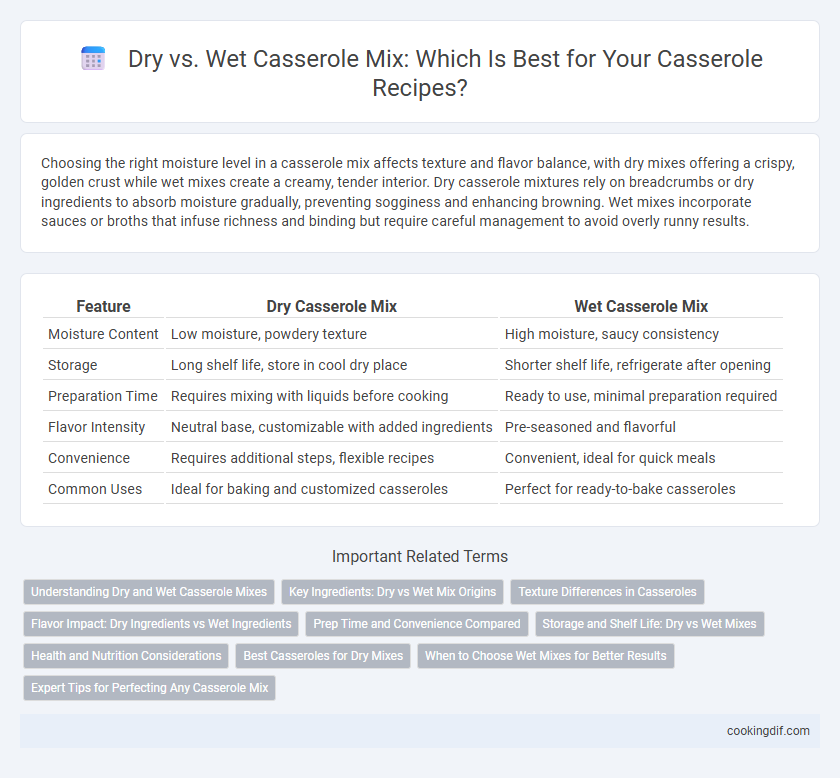Choosing the right moisture level in a casserole mix affects texture and flavor balance, with dry mixes offering a crispy, golden crust while wet mixes create a creamy, tender interior. Dry casserole mixtures rely on breadcrumbs or dry ingredients to absorb moisture gradually, preventing sogginess and enhancing browning. Wet mixes incorporate sauces or broths that infuse richness and binding but require careful management to avoid overly runny results.
Table of Comparison
| Feature | Dry Casserole Mix | Wet Casserole Mix |
|---|---|---|
| Moisture Content | Low moisture, powdery texture | High moisture, saucy consistency |
| Storage | Long shelf life, store in cool dry place | Shorter shelf life, refrigerate after opening |
| Preparation Time | Requires mixing with liquids before cooking | Ready to use, minimal preparation required |
| Flavor Intensity | Neutral base, customizable with added ingredients | Pre-seasoned and flavorful |
| Convenience | Requires additional steps, flexible recipes | Convenient, ideal for quick meals |
| Common Uses | Ideal for baking and customized casseroles | Perfect for ready-to-bake casseroles |
Understanding Dry and Wet Casserole Mixes
Dry casserole mixes typically contain dehydrated ingredients such as powdered soups, dried vegetables, and seasonings that require the addition of liquids like water, broth, or milk to rehydrate and create the sauce. Wet casserole mixes come pre-mixed with sauces, gravies, or cream-based liquids, providing immediate moisture and flavor without additional liquid preparation. Understanding these differences helps in achieving the desired texture and consistency, as dry mixes offer customization flexibility while wet mixes provide convenience and uniform flavor.
Key Ingredients: Dry vs Wet Mix Origins
Dry casserole mixes often originate from traditional pantry staples such as flour, dried herbs, and dehydrated vegetables, providing a base that absorbs moisture during cooking. Wet mixes typically include fresh or canned ingredients like cream soups, sauces, or beaten eggs, which introduce moisture and richness, affecting texture and flavor development. Understanding the balance between dry and wet components is crucial for achieving the desired consistency and taste in classic casserole recipes.
Texture Differences in Casseroles
Dry casserole mixes create a dense, crumbly texture that holds shape well, ideal for layered dishes or baked pasta. Wet casserole mixes produce a moist, creamy consistency, allowing flavors to meld and enhancing tenderness. Texture differences significantly impact the overall mouthfeel and presentation of a casserole dish.
Flavor Impact: Dry Ingredients vs Wet Ingredients
Dry ingredients in casserole mixes, such as herbs, spices, and powdered seasonings, provide concentrated bursts of flavor that infuse the dish subtly but effectively. Wet ingredients like broth, sauces, or dairy contribute moisture that enhances texture and helps distribute flavors evenly throughout the casserole. Balancing dry and wet components is essential to achieving a harmonious flavor profile and preventing the dish from becoming either too bland or overly soggy.
Prep Time and Convenience Compared
Dry casserole mixes typically offer shorter prep times due to fewer ingredients and simplified steps, enhancing convenience for quick meals. Wet casserole mixes, while often richer in flavor and moisture, require longer preparation and cooking times, which may reduce overall convenience. Choosing between dry and wet mixes depends on balancing desired taste and texture against available time and ease of preparation.
Storage and Shelf Life: Dry vs Wet Mixes
Dry casserole mixes typically have a longer shelf life, often lasting up to 12 months when stored in airtight containers in a cool, dry place, making them ideal for bulk storage. Wet casserole mixes require refrigeration and generally last only 3 to 5 days, due to moisture content promoting bacterial growth. Proper storage conditions significantly impact the freshness and safety of both dry and wet casserole mixes.
Health and Nutrition Considerations
Dry casserole mixes often contain higher sodium and preservatives to extend shelf life, which can impact heart health and increase blood pressure. Wet casserole mixes typically have added sugars and fats that raise calorie content and may contribute to weight gain and insulin resistance. Choosing homemade or minimally processed casseroles allows better control over nutrient density, reducing unhealthy additives while enhancing fiber, vitamins, and minerals.
Best Casseroles for Dry Mixes
Dry mixes for casseroles are ideal for recipes requiring a crispy, golden crust and a tender interior, often including ingredients like breadcrumbs, crushed crackers, or dry seasoning blends. These mixes absorb moisture from condensed soups or added dairy, resulting in a balanced texture and enhanced flavor depth. Popular dry mix casseroles include cheesy broccoli rice, tuna noodle, and classic chicken and stuffing varieties that benefit from the controlled moisture absorption of dry ingredients.
When to Choose Wet Mixes for Better Results
Wet casserole mixes are ideal when aiming for a moist and tender texture, especially in recipes containing lean meats or delicate vegetables. Opting for a wet mix enhances flavor infusion and prevents dryness during baking by maintaining moisture throughout the cooking process. This choice is particularly beneficial in layered casseroles requiring even cooking and cohesive binding of ingredients.
Expert Tips for Perfecting Any Casserole Mix
Expert tips for perfecting any casserole mix emphasize balancing dry and wet ingredients to achieve ideal texture and flavor. Incorporate breadcrumbs or crushed crackers as dry components to add crunch, while using broth, cream, or sauces ensures moisture and richness. Adjust proportions based on ingredient absorbency, aiming for a cohesive but not soggy consistency for the perfect casserole.
Dry vs wet for casserole mix Infographic

 cookingdif.com
cookingdif.com